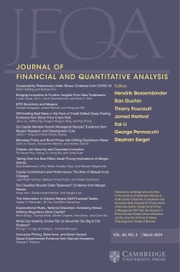Crossref Citations
This article has been cited by the following publications. This list is generated based on data provided by
Crossref.
David, Alexander
1998.
Pricing the Strategic Value of Poison Put Bonds.
Finance and Economics Discussion Series,
Vol. 1998.0,
Issue. 6,
p.
1.
David, Alexander
1998.
Pricing the Strategic Value of Poison Put Bonds.
SSRN Electronic Journal ,
Tauren, Miikka Petteri
1999.
A Model of Corporate Bond Prices with Dynamic Capital Structure.
SSRN Electronic Journal ,
BOHN, JEFFREY R.
2000.
A Survey of Contingent‐Claims Approaches to Risky Debt Valuation.
The Journal of Risk Finance,
Vol. 1,
Issue. 3,
p.
53.
Wahrenburg, Mark
and
Niethen, Susanne
2000.
Vergleichende Analyse alternativer Kreditrisikomodelle.
Credit and Capital Markets – Kredit und Kapital,
Vol. 33,
Issue. 2,
p.
235.
Kijima, Masaaki
and
Muromachi, Yukio
2000.
Credit Events and the Valuation of Credit Derivatives of Basket Type.
Review of Derivatives Research,
Vol. 4,
Issue. 1,
p.
55.
Kao, Duen-Li
2000.
Estimating and Pricing Credit Risk: An Overview.
Financial Analysts Journal,
Vol. 56,
Issue. 4,
p.
50.
HUI, C. H.
and
LO, C. F.
2000.
A NOTE ON RISKY BOND VALUATION.
International Journal of Theoretical and Applied Finance,
Vol. 03,
Issue. 03,
p.
575.
Bakshi, Gurdip
Madan, Dilip B.
and
Zhang, Frank X.
2001.
Investigating the Sources of Default Risk: Lessons from Empirically Evaluating Credit Risk Models.
Finance and Economics Discussion Series,
Vol. 2001.0,
Issue. 15,
p.
1.
David, Alexander
2001.
Pricing the strategic value of putable securities in liquidity crises.
Journal of Financial Economics,
Vol. 59,
Issue. 1,
p.
63.
Mueller, Clemens
2001.
A Simple Multi-Factor Model of Corporate Bond Prices.
SSRN Electronic Journal ,
Bakshi, Gurdip S.
Madan, Dilip B.
and
Zhang, Frank Xiaoling
2001.
Investigating the Sources of Default Risk: Lessons from Empirically Evaluating Credit Risk Models.
SSRN Electronic Journal ,
Cao, Melanie
and
Wei, Jason
2001.
Vulnerable options, risky corporate bond, and credit spread.
Journal of Futures Markets,
Vol. 21,
Issue. 4,
p.
301.
Ericsson, Jan
and
Reneby, Joel
2001.
Estimating Structural Bond Pricing Models.
SSRN Electronic Journal ,
Collin‐Dufresne, Pierre
and
Goldstein, Robert S.
2001.
Do Credit Spreads Reflect Stationary Leverage Ratios?.
The Journal of Finance,
Vol. 56,
Issue. 5,
p.
1929.
Acharya, Viral V.
and
Carpenter, Jennifer N.
2001.
Corporate Bond Valuation and Hedging with Stochastic Interest Rates and Endogenous Bankruptcy.
SSRN Electronic Journal ,
Collin-Dufresn, Pierre
Goldstein, Robert S.
and
Martin, J. Spencer
2001.
The Determinants of Credit Spread Changes.
The Journal of Finance,
Vol. 56,
Issue. 6,
p.
2177.
Choudhry, Moorad
2001.
The Bond & Money Markets.
p.
794.
Francois, Pascal
and
Hubner, Georges
2001.
Credit Derivatives with Multiple Debt Issues.
SSRN Electronic Journal ,
Uhrig-Homburg, Marliese
2002.
Valuation of Defaultable Claims — A Survey.
Schmalenbach Business Review,
Vol. 54,
Issue. 1,
p.
24.

